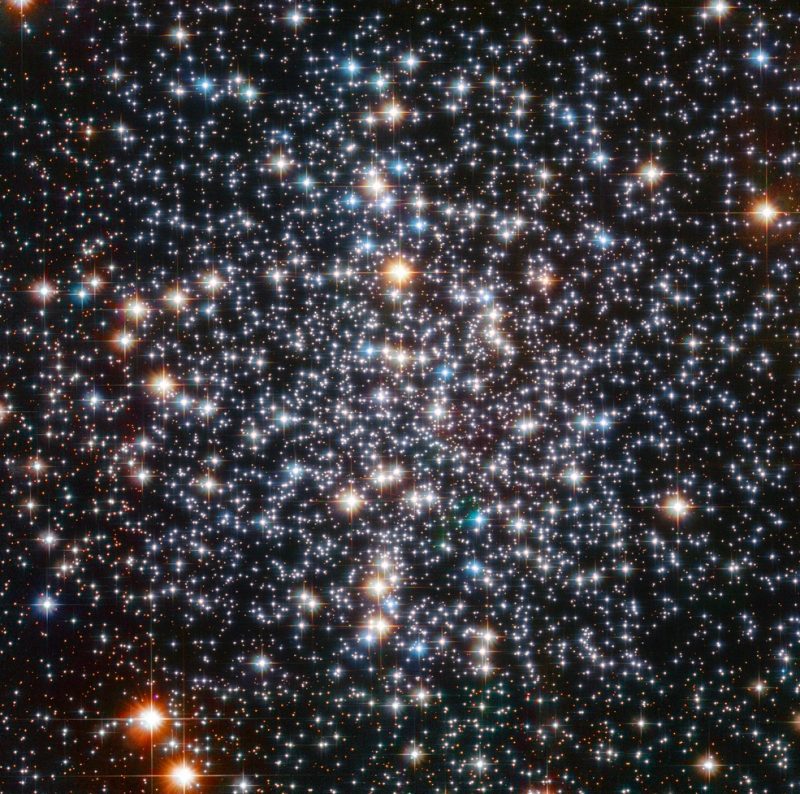Scientists using the Hubble Space Telescope have found evidence for an intermediate-mass black hole in the closest globular cluster to Earth, Messier 4.
NASA published this original story on May 23, 2023. Edits by EarthSky.
The 3 types of black holes
Astronomers using NASA’s Hubble space telescope have powerful evidence for the presence of a rare class of intermediate-mass black holes that might be lurking in the heart of the closest globular star cluster to Earth – Messier 4 – located somewhere between 6,000 to 7,200 light-years away.
Black holes are like intense gravitational potholes in the fabric of space, and they all seem to come in two sizes: small and humongous. Scientists estimate that 100 million small black holes litter our galaxy. These small black holes, created from exploded stars, are several times the mass of our sun. Meanwhile, supermassive black holes flood the universe at large. These behemoths weigh millions or billions of times our sun’s mass and lie at the centers of galaxies.
But scientists have long-sought a missing link: the intermediate-mass black hole. These black holes would weigh somewhere between 100 and 100,000 solar masses. How would they form, where would they hang out, and why do they seem so rare?
Hunting for an intermediate-mass black hole
Astronomers have identified other possible intermediate-mass black holes through a variety of observational techniques. Two of the best candidates — 3XMM J215022.4-055108, which Hubble helped discover in 2020, and HLX-1, identified in 2009 — reside in dense star clusters in the outskirts of other galaxies. Each of these possible black holes has the mass of tens of thousands of suns. And, they may have once been at the centers of dwarf galaxies. NASA’s Chandra X-ray observatory has also helped make many possible intermediate black hole discoveries, including a large sample in 2018.
Looking much closer to home, scientists have detected many suspected intermediate-mass black holes in dense globular star clusters orbiting our Milky Way galaxy. For example, in 2008, Hubble astronomers announced the suspected presence of an intermediate-mass black hole in the globular cluster Omega Centauri. For many reasons, including the need for more data, these and other intermediate-mass black hole findings still remain inconclusive and do not rule out alternative theories.

Targeting M4
Scientists have now used Hubble to zero in on the core of the globular star cluster Messier 4 (M4). They’re black-hole hunting with higher precision than was possible in previous searches. Eduardo Vitral of the Space Telescope Science Institute in Baltimore, Maryland, is the lead author on a paper to be published in the Monthly Notices of the Royal Astronomical Society.
Vitral’s team has detected a possible intermediate-mass black hole of roughly 800 solar masses. The suspected object isn’t visible. However, the team can calculate its mass by studying the motion of stars caught in its gravitational field, like bees swarming around a hive. Measuring their motion takes time and a lot of precision. This is where Hubble accomplishes what no other present-day telescope can do. Astronomers looked at 12 years’ worth of M4 observations from Hubble and resolved pinpoint stars.
His team estimates that the black hole in M4 could be as much as 800 times our sun’s mass. Hubble’s data tend to rule out alternative theories for this object. Some of those theories would be a compact central cluster of unresolved stellar remnants like neutron stars, or smaller black holes swirling around each other. Vitral said:
We have good confidence that we have a very tiny region with a lot of concentrated mass. It’s about three times smaller than the densest dark mass that we had found before in other globular clusters. The region is more compact than what we can reproduce with numerical simulations when we take into account a collection of black holes, neutron stars, and white dwarfs segregated at the cluster’s center. They are not able to form such a compact concentration of mass.
Eliminating alternatives to the intermediate-mass black hole
A grouping of close-knit objects would be dynamically unstable. If the object isn’t a single intermediate-mass black hole, it would require an estimated 40 smaller black holes crammed into a space only 1/10 of a light-year across to produce the observed stellar motions. The consequences are that they would merge and/or be ejected in a game of interstellar pinball. Vitral explained their process:
We measure the motions of stars and their positions, and we apply physical models that try to reproduce these motions. We end up with a measurement of a dark mass extension in the cluster’s center. The closer to the central mass, more randomly the stars are moving. And, the greater the central mass, the faster these stellar velocities.
Because intermediate-mass black holes in globular clusters have been so elusive, Vitral cautions:
While we cannot completely affirm that it is a central point of gravity, we can show that it is very small. It’s too tiny for us to be able to explain other than it being a single black hole. Alternatively, there might be a stellar mechanism we simply don’t know about, at least within current physics.
Bottom line: Scientists using the Hubble space telescope have found evidence for an intermediate-mass black hole in the closest globular cluster to Earth, M4.











